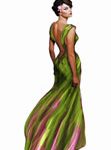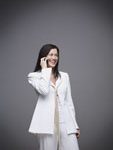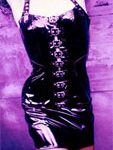
COLOR PSYCHOLOGY
Our personal and cultural associations affect our experience of color. Colors are seen as warm or cool mainly because of long-held associations. Yellow, orange and red are associated with the heat of sun and fire; blue, green and violet with the coolness of leaves, sea and the sky. Warm colors seem closer to the viewer than cool colors, but vivid cool colors can overwhelm light and subtle warm colors. Using warm colors for foreground and cool colors for background enhances the perception of depth.
Market researchers have done extensive studies exploring the emotional responses of people to color. Some of these responses seem to be powerful and fairly universal. However, much of this information is culturally biased. We know that cultural traditions endow colors with powerful meanings that can differ greatly from place to place. For example, in Europe and the United States, black is the color of mourning. In many tropical countries and in East Asia white is the color of death. On the other hand, white is the color worn by American brides, while brides in much of Asia wear red. Based on research done in the United States and Europe,we know that the following associations are generally found to hold in Euro-American societies.
Here is a list of colors and their effect:
Red: is associated with blood, and with feelings that are energetic, exciting, passionate or erotic. Most colors carry both positive and negative implications. The downside of red evokes aggressive feelings, suggesting anger or violence.
Orange: is the color of flesh, or the friendly warmth of the hearth fire. The positive implications of this color suggest approachability, informality. The negative side might imply accessibility to the point of suggesting that anyone can approach– a lack of discrimination or quality.
Blue: suggests coolness, distance, spirituality, or perhaps reserved elegance. Some shade of blue is flattering to almost anyone. In its negative mode, we can think of the “blues”-the implication being one of sadness, passivity, alienation, or depression.Experts recommend putting a blue light in your fridge when you are dieting, as this will put you off eating. You can also try using blue plates, blue placemats, and a blue dining area.
Yellow: is the color of sunshine. This color is optimistic, upbeat, modern. The energy of yellow can become overwhelming. Therefore yellow is not a color that tends to dominate fashion for long periods of time.Yellow is also appetite stimulating, because it relates to happiness.
Green: In its positive mode, green suggests nature (plant life, forests), life, stability, restfulness, naturalness. On the other hand, green in some tones or certain contexts (such as green skin) might instead suggest decay (fungus, mold), toxicity, artificiality.Green is associated with nature, health and abundance, and is often used to show a product’s safety. Because of its connection to nature, Green is considered a calming and relaxing color. Green foods are interpreted to be healthy.
Grey: It muffles appetite and even causes disgust for meal! Grey color does not cause irritation, but thus it calms and muffles anxiety, and together with it and appetite.
Turquoise: It stimulates appetite. Orange and turquoise shades, and also their combinations concern to “tasty” colors. If you even will hang up a picture of these colors on kitchen and will look at it during meal you quickly will get rid of excessive leanness.
Violet is the color of fantasy, playfulness, impulsiveness, and dream states. In its negative mode, it can suggest nightmares, or madness.
Green, brown, and red are the most popular food colors. Red and yellow are often used in restaurant decorating schemes because they are appetite stimulant. In order to lose weight, you should eat your food on a black or dark plate. These dark colors subconsciously diminish your appetite. Furthermore, dinner should be eaten on the dark plates but breakfast should be eaten on bright plates.Market research on color is also done to establish color trends. Color forecasting is accomplished by surveying consumer preferences and other indicators of changes in taste









Its like you read my mind! You appear to know a lot about this, like you wrote the book in it or something. I think that you could do with some pics to drive the message home a bit, but instead of that, this is magnificent blog. A fantastic read. I’ll certainly be back.
gives use a terrific web page decent Gives thanks for the effort to support people